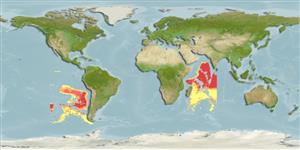Classification / Names
প্রচলিত নাম সমূহ | প্রতিনাম সমূহ | Catalog of Fishes(গণ , প্রজাতি ) | ITIS | CoL | WoRMS | Cloffa
>
Alepocephaliformes (Slickheads and tubeshoulders.) >
Alepocephalidae (Slickheads)
Etymology: Bathytroctes: Greek, bathys = deep + Greek, trokta, -on = sweets for dessert; also = troktos, -e, -on = edible (Ref. 45335).
Environment: milieu / climate zone / depth range / distribution range
বাস্তুসংস্থান
সামুদ্রিক সমুদ্রবক্ষে ভাসমান (ব্যথিপেলাজিক); গভীরতার পরিসীমা 3940 - 4820 m (Ref. 34286). Deep-water
Indian Ocean: Somali and Arabian basins. Eastern Central Pacific: off Guatemala. Northeast Atlantic: Iberian basin.
আকৃতি / ওজন / Age
Maturity: Lm ? range ? - ? cm
Max length : 24.2 cm SL পুরুষ/ লিঙ্গ অনিধর্ারিত ; (Ref. 34286)
Life cycle and mating behavior
Maturities | প্রজনন | Spawnings | Egg(s) | Fecundities | শুককীট
Sazonov, Y.I., 1999. On the revision of the genus Bathytroctes Günther (Alepocephalidae): a review of the abyssobenthopelagic forms (previously referred to the genus Nomoctes) with a description of two new species. J. Ichthyol. 39(9):699-712. (Ref. 34286)
IUCN Red List Status (Ref. 130435)
Threat to humans
Harmless
Human uses
হাতিয়ার
Special reports
Download XML
ইন্টারনেট সুত্র
Estimates based on models
Preferred temperature (Ref.
123201): 1.3 - 1.8, mean 1.6 °C (based on 1416 cells).
Phylogenetic diversity index (Ref.
82804): PD
50 = 0.5005 [Uniqueness, from 0.5 = low to 2.0 = high].
Bayesian length-weight: a=0.01000 (0.00244 - 0.04107), b=3.04 (2.81 - 3.27), in cm total length, based on all LWR estimates for this body shape (Ref.
93245).
ট্রফিক পর্যায়ে (Ref.
69278): 3.5 ±0.5 se; based on size and trophs of closest relatives
স্থিতিস্থাপক (Ref.
120179): মাধ্যম , সর্বনিম্ন প্রজন দ্বিগুনের সময় ১.৪-৪.৪ বৎসর (Preliminary K or Fecundity.).
Fishing Vulnerability (Ref.
59153): Low vulnerability (20 of 100).
